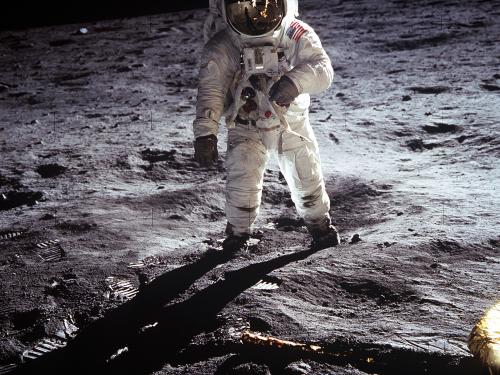
Stories of daring, stories of technological feats, stories of prevailing against the odds ... these are the stories we tell at the National Air and Space Museum. Dive in to the stories below to discover, learn, and be inspired.
Showing 81 - 90 of 91

December 30, 2011
After pressing some buttons to start up the ascent engine of their lunar module Challenger, astronauts Gene Cernan and Harrison Schmitt left the Moon on December 14, 1972. That’s 39 years ago – before many of us were even born. While these men looked out the tiny triangular windows of the lunar module to see the lunar surface getting farther away, viewers around the world watched that same spacecraft leave the Moon, live and in color on their television sets.

December 21, 2010
I was pleasantly surprised when the clouds rolled out and the weather turned out to be favorable for the total lunar eclipse last night!

December 17, 2010
The Moon is one of the most easily recognized celestial objects and arguably the easiest one to observe. It is simple to view the changing phases from day to day, with your naked eyes. Binoculars or a telescope will reveal countless craters, ancient lava flows, and other intriguing lunar features.

October 05, 2010
“Remote sensing” is a term used to describe many different types of observations carried out at a distance. Aerial photos, satellite images of the Earth and planets, and telescope views of our solar system are all forms of remote sensing used to understand geology, climate, hazards, and changes over time.

April 01, 2010
In the summer of 2009 the United States celebrated the fortieth anniversary of the first Moon landing, Apollo 11. Amidst all of the hoopla virtually every news story, especially in the electronic world, made some comment about a supposedly rising belief that humans have never landed on the Moon. Why?

January 22, 2010
For more than a decade it has been my privilege, among my other duties, to serve as curator of the National Air and Space Museum art collection. It comes as a surprise to many folks to realize that the Museum has an art collection. In fact, it includes over 4,700 works by artists with names like Daumier, Goya, Rauschenberg, Rockwell and Wyeth.

November 03, 2009
The National Air and Space Museum is holding its first ever virtual conference for educators on Tuesday, November 10 from 11 a.m. – 5 p.m. EST. Since we’re in the middle of the 40th anniversary commemorations of the Apollo missions, we decided to focus on this important period in American history. Staff from our Division of Space History will discuss some fascinating topics such as the real story behind President Kennedy’s famous speech challenging Congress to send Americans to the Moon; the role of computers—a new technology in the 1960s; the myth of presidential leadership during this time period; the intersections of Ralph Abernathy, the Civil Rights Movement, and the Moon landing; the rise of six iconic Apollo images and how they have been used over time; and the denials of the Moon landings by a small segment of the population and their evolution since the 1960s.

July 15, 2009
When the Apollo 11 spacecraft lifted off on July 16, 1969, for the Moon, it signaled a climactic instance in human history. Reaching the Moon on July 20, its Lunar Module—with astronauts Neil A. Armstrong and Buzz Aldrin aboard—landed on the lunar surface while Michael Collins orbited overhead in the Apollo 11 command module. Armstrong soon set foot on the surface, telling millions on Earth that it was “one small step for [a] man—one giant leap for mankind.” Aldrin soon followed him out and the two planted an American flag but omitted claiming the land for the U.S. as had been routinely done during European exploration of the Americas, collected soil and rock samples, and set up scientific experiments. The next day they returned to the Apollo capsule overhead and returned to Earth, splashing down in the Pacific Ocean on July 24.

July 14, 2009
Regular summer visitors to the National Air and Space Museum are familiar with the Museum’s popular event, Mars Day. This year, Mars is taking a backseat to allow us to honor the 40th Anniversary of the Apollo 11 lunar landing with Countdown to the Moon Day.

July 13, 2009
What will the astronauts who return to the Moon with NASA’s Constellation program drive? I had a chance to find out last October as a member of NASA's Desert Research and Technology Studies (Desert RATS) during the field test of the Lunar Electric Rover (LER) at Black Point lava flow in Arizona.
